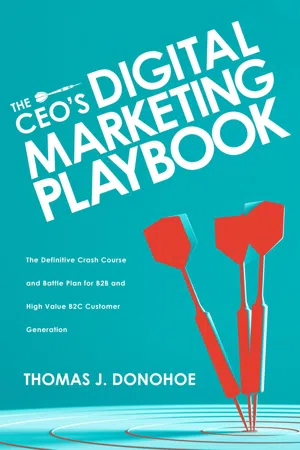
The CEO's Digital Marketing Playbook
The Definitive Crash Course and Battle Plan for B2B and High Value B2C Customer Generation
- English
- ePUB (mobile friendly)
- Available on iOS & Android
The CEO's Digital Marketing Playbook
The Definitive Crash Course and Battle Plan for B2B and High Value B2C Customer Generation
About this book
The CEO's Digital Marketing Playbook is the definitive playbook and crash course for both the baseline and advanced digital and direct marketing that every company on Earth needs to deploy in the 21st Century. Unlike the hundreds of books about social media or online advertising concepts, this step by step guide lays out every strategy and tactic that is essential to achieving the single greatest achievement in marketing: driving new customers and doing so profitably.
Every CEO, from startup to Fortune 100, needs to understand every concept in this book or risk bleeding money and opportunity, which 99% are doing whether they know it or not. Every marketing professional and small business owner needs to embrace the tactics laid out or risk being bad at their job of profitable customer generation and best practice marketing.
In just over 200 pages, every business professional can become a smart, customer generation focused digital marketer by following this playbook.
Frequently asked questions
- Essential is ideal for learners and professionals who enjoy exploring a wide range of subjects. Access the Essential Library with 800,000+ trusted titles and best-sellers across business, personal growth, and the humanities. Includes unlimited reading time and Standard Read Aloud voice.
- Complete: Perfect for advanced learners and researchers needing full, unrestricted access. Unlock 1.4M+ books across hundreds of subjects, including academic and specialized titles. The Complete Plan also includes advanced features like Premium Read Aloud and Research Assistant.
Please note we cannot support devices running on iOS 13 and Android 7 or earlier. Learn more about using the app.
Information

- We need to start defining some core, daily-used digital marketing terms, buzzwords, and acronyms with a brief glossary.
- The digital advertising channels that are the main drivers to customer generation.
- The type of creative (words, images, etc.) needed to ensure efficiency in striving for better ROI. Creative = anything a prospective customer sees, like ads or websites or content, which can help or hurt someone taking action. UX/UI (user experience, user interface) is important as well when turning potential customers into customers, but that’s for another discussion and is less low hanging fruit/large impact than the other topics covered here.
- The types of websites prospective customers experience as part of a digital and direct marketing strategy. (Hint: it isn’t your homepage.)
- The data, reporting, and marketing attribution concepts necessary to know what’s really happening to your marketing budget; what specific actions your money is creating and the value of those customer actions.
- The difference between proprietary digital advertising and using pay per lead (“PPL”) affiliates and if your industry should care. (Hint: most shouldn’t; those that do REALLY do.)

Table of contents
- Cover
- Praise for The CEO’s Digital Marketing Playbook
- Title
- Copyright
- The Marketer’s Raison d’Etre
- Why I’m Here
- Table of Contents
- Introduction—The Kingdom and The Power of Digital Direct Response
- CHAPTER 1—The Essential Glossary on the ad channels, technology and terms. If you can’t speak the language, you can’t manage a 21st Century Marketing team. And if you think you know the language just because you’re a CEO or CMO, I beg you to reconsider and dive in to refresh
- CHAPTER 2—The Essential Marketing Strategy and Team Structure for Every Company: Your general foundation, philosophy, and strategy for direct response marketing, regardless of industry
- CHAPTER 3—The CORE FOUR Tactics— The “C4” for every single company selling anything to anyone
- CHAPTER 4—The ADVANCED EIGHT Tactics— The “A8” Long-term, Wholistic Marketing Playbook Beyond the Core Four Digital. Eight universal digital and direct marketing tactics that work together to allow an effective direct response plan to scale
- CONCLUSION AND CHEAT SHEET
- Acknowledgments